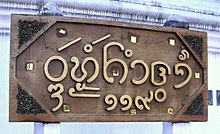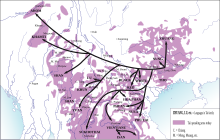
A | B | C | D | E | F | G | H | CH | I | J | K | L | M | N | O | P | Q | R | S | T | U | V | W | X | Y | Z | 0 | 1 | 2 | 3 | 4 | 5 | 6 | 7 | 8 | 9
| Northern Thai | |
|---|---|
| ᨣᩴᩤᨾᩮᩬᩥᨦ กำเมือง | |
 Tai Tham script traditional transcription (top) Thai alphabet currently popular with non-standard form (bottom) | |
| Pronunciation | [kam˧.mɯaŋ˧], |
| Native to | Thailand (Chiang Mai, Lamphun, Lampang, Uttaradit, Phrae, Nan, Phayao, Chiang Rai, Mae Hong Son and Communities throughout Thailand) Myanmar (Tachileik, Myawaddy) Laos (Houayxay, Ton Pheung) |
| Region | Northern Thailand |
| Ethnicity | Northern Thai |
Native speakers | 6 million (2015)[1] |
Kra–Dai
| |
| Tai Tham script Thai script | |
| Official status | |
Recognised minority language in | |
| Language codes | |
| ISO 639-3 | nod |
| Glottolog | nort2740 |
Kam Mueang (Northern Thai: ᨣᩴᩤᨾᩮᩬᩥᨦ, กำเมือง ) or Northern Thai language (Thai: ภาษาไทยถิ่นเหนือ) is the language of the Northern Thai people of Lanna, Thailand. It is a Southwestern Tai language that is closely related to Tai Lue language. Kam Mueang has approximately six million speakers, most of whom live in the native Northern Thailand, with a smaller community of Lanna speakers in northwestern Laos.
Speakers of this language generally consider the name "Tai Yuan" to be pejorative[citation needed]. They refer to themselves as Khon Mueang (ᨤᩫ᩠ᨶᨾᩮᩬᩥᨦ, คนเมือง, [kʰon˧.mɯaŋ˧] – literally "people of Mueang" meaning "city dwellers"), Lanna, or Northern Thai. The language is also sometimes referred to as Phayap (พายัพ, Thai pronunciation: [pʰāː.jáp]), "Northwestern (speech)".
The term Yuan is still sometimes used for Northern Thai's distinctive Tai Tham alphabet, which is closely related to the old Tai Lue alphabet and the Lao religious alphabets. The use of the Tua Mueang, as the traditional alphabet is known, is now largely limited to Buddhist temples, where many old sermon manuscripts are still in active use. There is no active production of literature in the traditional alphabet, and when used in writing standard Thai script is invariably used. The modern spoken form is called Kam Mueang. There is a resurgence of interest in writing it in the traditional way, but the modern pronunciation differs from that prescribed in spelling rules.[2]

Classification
Northern Thai is classified as one of the Chiang Saen languages—others being Thai, Southern Thai and numerous smaller languages, which together with the Northwestern Tai and Lao-Phutai languages, form the Southwestern branch of Tai languages. The Tai languages are a branch of the Kra–Dai language family, which encompasses a large number of indigenous languages spoken in an arc from Hainan and Guangxi south through Laos and Northern Vietnam to the Cambodian border.
From a purely genealogical standpoint, most linguists consider Northern Thai to be more closely related to Central Thai than to Lao or Isan, but the language has been heavily influenced by both Lao and Central Thai throughout history. All Southwestern Tai languages form a coherent dialect continuum of more or less mutually intelligible varieties, with few sharp dividing lines. Nevertheless, Northern Thai has today become closer to the Central Thai language, as Standard Thai is the principal language of education and government and spoken throughout Thailand.
| Kra-Dai |
| |||||||||||||||||||||||||||||||||||||||||||||||||||
Names
The Northern Thai language has various names in Northern Thai, Thai, and other Tai languages.
- In Northern Thai, it is commonly called kam mueang (ᨣᩴᩤᨾᩮᩬᩥᨦ, /kām.mɯ̄aŋ/, literally "city language"; cf. Standard Thai: คำเมือง /kʰām.mɯ̄aŋ/), or phasa Lan Na (ᨽᩣᩈᩣᩃ᩶ᩣ᩠ᨶᨶᩣ, ภาษาล้านนา /pʰāː.sǎː.láːn.nāː/, literally "the language of Lan Na").
- In Central Thai and Southern Thai, Northern Thai is known as phasa thin phayap (ภาษาถิ่นพายัพ /pʰāː.sǎː.tʰìn.pʰāː.jáp/, literally "the language of the northwestern region"), or phasa thai thin nuea (ภาษาไทยถิ่นเหนือ /pʰāː.sǎː.tʰāj.tʰìn.nɯ̌a/, literally "the Thai language of the northern region", or colloquially it is known as phasa nuea (ภาษาเหนือ /pʰāː.sǎː.nɯ̌a/, literally "the northern language").
- In Lao, it is known as phasa nyuan or phasa nyon (ພາສາຍວນ or ພາສາໂຍນ respectively, /pʰáː.sǎː.ɲúan/ or /pʰáː.sǎː.ɲóːn/ respectively, literally "the Tai Yuan language").
- In Tai Lü, it is known as kam yon (ᦅᧄᦍᦷᧃ kâm.jôn, literally "the Tai Yuan language").
- In Shan it is known as kwam yon (ၵႂၢမ်းယူၼ်း kwáːm.jón, literally "the Tai Yuan language").
History
Tai migration

The ancestors of the Northern Thai people were speakers of Southwestern Tai dialects that migrated from what is now southeastern China, specifically what is now Guangxi and northern Vietnam where the diversity of various Tai languages suggests an Urheimat. The Southwestern Tai languages began to diverge from the Northern and Central branches of the Tai languages, covered mainly by various Zhuang languages, sometime around 112 AD, but likely completed by the sixth century.[3] Due to the influx of Han Chinese soldiers and settlers, the end of the Chinese occupation of Vietnam, the fall of Jiaozhi and turbulence associated with the decline and fall of the Tang dynasty led some of the Tai peoples speaking Southwestern Tai to flee into Southeast Asia, with the small-scale migration mainly taking place between the eighth and twelfth centuries. The Tais split and followed the major river courses, with the ancestral Northern Thai originating in the Tai migrants that followed the Mekong River.[4]
Indianized kingdoms
Ancestors of the Northern Thai people established Ngoenyang, an early kingdom that existed between the 7th to 13th centuries, as well as smaller kingdoms like Phayao, in what is now modern-day northern Thailand. They settled in areas adjacent to the kingdom of Hariphunchai, coming into contact with Mon-speaking people whose writing system was eventually adapted for the Northern Thai language as the Tai Tham script.[5] In the 13th century, King Mangrai consolidated control of these territories, establishing the kingdom of Lan Na. In the 15th century, King Tilokkarat ushered in a golden age for Northern Thai literature, with a profusion of palm leaf manuscripts written in Tai Tham, using vernacular Northern Thai and interspersed with Pali and Buddhist Indic vocabulary.[6][5]
Thai subordination
In 1775, Kawila of Lampang revolted with Siamese assistance, and captured the city, ending 200 years of Burmese rule. Kawila was installed as the prince of Lampang and Phraya Chaban as the prince of Chiang Mai, both as vassals of Siam. In 1899, Siam annexed the Northern Thai principalities, effectively dissolving their status as sovereign tributary states.
The Compulsory Education Act of 1921 banned schools and temples from using languages other than Central Thai (standard Thai), in an effort to bring remote regions under Siamese control.[5] Northern Thai was relegated from the public sphere, with influential religious leaders like Khruba Srivichai jailed for using Northern Thai in sermons.[5] In the 1940s, authorities promulgated Thai cultural mandates that reinforced the importance of learning and using Central Thai as the prestige language.[5]
These economic and educational pressures have increased the use of standard Thai to the detriment of other regional languages like Northern Thai.[7][8] Today, Northern Thai is typically code-switched with standard Thai, especially in more developed and urbanized areas of Northern Thailand, whereas exclusive use of Northern Thai remains prevalent in more remote areas.[8]
Dialects
Thanajirawat (2018)[9] classifies Tai Yuan into five major dialect groups based on tonal split and merger patterns. (See also Proto-Tai language#Tones)
- most Tai Yuan varieties in Thailand, Laos and Myanmar
- Bokeo Province, Laos (A12-34 and BCD123-4 (B4=DL4=DS4))
- Mae Chaem District, Chiang Mai Province and Laplae District, Uttaradit Province, Thailand (A12-34 and BCD123-4 (A34=B123=DL123))
- Tha Pla District, Uttaradit Province and Xayaburi Province, Laos (A12-34, BDL1234, and CDS123-4)
- Ratchaburi Province, Thailand (A12-34 and BCD123-4 (A34=B123=DL123, B4=C4=DL4))
Phonology
Consonants
Initial consonants
Northern Thai consonant inventory is similar to that of Lao (Isan); both languages have the /ɲ/ sound and lack /tɕʰ/.
| Labial | Dental/ Alveolar |
(Alveolo-) Palatal |
Velar | Glottal | ||
|---|---|---|---|---|---|---|
| Nasal | /m/ ᨾ ᩉ᩠ᨾ ม |
/n/ ᨶ ᨱ ᩉ᩠ᨶ ณ, น |
/ɲ/ ᨿ ᨬ ᩉ᩠ᨿ ญ, ย |
/ŋ/ ᨦ ᩉ᩠ᨦ ง |
||
| Plosive/ Affricate |
tenuis | /p/ ᨸ ᨻ ป |
/t/ ᨲ ᨴ ᨭ ฏ, ต |
/tɕ/ ᨧ ᨩ จ |
/k/ ᨠ ᨣ ก |
/ʔ/[a] ᩋ อ |
| aspirate | /pʰ/ ᨹ ᨽ ᨷᩕ ᨸᩕ ᨻᩕ ผ, พ, ภ |
/tʰ/ ᨳ ᨮ ᨵ ᨰ ᨲᩕ ᨴᩕ ฐ, ฑ, ฒ, ถ, ท, ธ |
(/tɕʰ/)[b] ฉ, ช, ฌ |
/kʰ/ ᨡ ᨤ ᨥ ᨠᩕ ᨣᩕ ᨢ ᨡᩕ ข, ฃ, ค, ฅ, ฆ |
||
| voiced | /b/ ᨷ บ |
/d/ ᨯ ฎ, ด |
||||
| Fricative | /f/ ᨺ ᨼ ฝ, ฟ |
/s/ ᩈ ᩇ ᩆ ᨨ ᨪ ᨫ ซ, ศ, ษ, ส |
(/x/)[b] | /h/ ᩉ ᩁ ᩌ ᩉᩕ ห, ฮ | ||
| Approximant | /w/ ᩅ ᩉ᩠ᩅ ว |
/l/ ᩃ ᩁ ᩉᩖ ᩉ᩠ᩃ ᩊ ล, ฬ |
/j/ ᩀ ย |
|||
| Rhotic/Liquid | (/r/)[b] ᩁ ᩊ ร |
|||||
- ^ Implied before any vowel without an initial and after a short vowel without a final.[what does 'implied' mean? is it there or not?]
- ^ a b c /tɕʰ/ and /r/ occur in loanwords from Central and Southern Thai. is also a common allophone of /kʰ/
Initial consonant clusters
There are two relatively common consonant clusters:
- /kw/ ᨠ᩠ᩅ ᨣ᩠ᩅ (กว) Zdroj:https://en.wikipedia.org?pojem=Northern_Thai_language
Text je dostupný za podmienok Creative Commons Attribution/Share-Alike License 3.0 Unported; prípadne za ďalších podmienok. Podrobnejšie informácie nájdete na stránke Podmienky použitia.
Antropológia
Aplikované vedy
Bibliometria
Dejiny vedy
Encyklopédie
Filozofia vedy
Forenzné vedy
Humanitné vedy
Knižničná veda
Kryogenika
Kryptológia
Kulturológia
Literárna veda
Medzidisciplinárne oblasti
Metódy kvantitatívnej analýzy
Metavedy
Metodika
Text je dostupný za podmienok Creative
Commons Attribution/Share-Alike License 3.0 Unported; prípadne za ďalších
podmienok.
Podrobnejšie informácie nájdete na stránke Podmienky
použitia.
www.astronomia.sk | www.biologia.sk | www.botanika.sk | www.dejiny.sk | www.economy.sk | www.elektrotechnika.sk | www.estetika.sk | www.farmakologia.sk | www.filozofia.sk | Fyzika | www.futurologia.sk | www.genetika.sk | www.chemia.sk | www.lingvistika.sk | www.politologia.sk | www.psychologia.sk | www.sexuologia.sk | www.sociologia.sk | www.veda.sk I www.zoologia.sk
